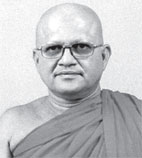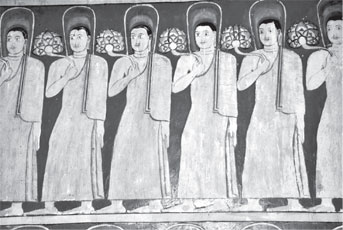|
Gandara Purana Vihara:
Samadhi Buddha statue to embellish ancient temple
by Nivanthi THILAKARATHNE
The foundation stone for the 60ft tall Samadhi Buddha statue and
shrine room was laid recently at the Gandara Purana Vihara in Matara.
The estimated cost of the project is Rs 50,000,000 and it will be
completed within five years. The history of the Matara district goes
back to the period before the arrival of legendary Prince Vijaya.
Ancient viharas and other archaeological monuments found in the area
show that the Matara district had been inhabited by highly civilised
people - such as the Nagas.
 |
|
Ven Kanumuldeniye
Upali thera |
The Gandara Purana Vihara is at the Gandara East Grama Niladhari
Division of Devinuwara Secretariat division. One can reach the vihara
travelling along the Matara – Kataragama road. It is 11 kilometres away
from the Matara city. According to legend, ‘Gandara’ is believed to have
been the village through which people reached the kingdom.
Therefore, it had been called ‘Grama Dwara’ which means entrance to
the village. Later it became ‘Gandora’ and subsequently ‘Gandara’.
Murals
There is evidence to prove that the vihara has been in existence
since in 18th century. Murals in the shrine room of the vihara belong to
the tradition of the Kandyan period. Its structure shows its
archaeological and artistic value.
The shrine room parts known as mandapa, pradakshina pataya and garba
gruhay. The pillars in the open area are believed to have been built
later. One can enter the pradakshina pataya through the main entrance
and later visit the garba gruhaya.
Tradition
Although the murals belong to the Kandyan period, some of them are
influenced by the southern tradition. The murals of the shrine room
appear to have been affected by the political, social, economic and
cultural impact in the colonised era. Especially Matara was affected by
Dutch and British rule.
 |
|
Murals in the shrine
room of the vihara |
Don Juwan Dharmapala, the king of Kotte had bequeathed the kingdom to
the Portuguese by a deed of gift and Matara was included in it. Although
Sinhalese kings captured power from time to time, the Portuguese again
ruled Matara in 1596.
They built a fortress in the following year. After the Portuguese,
the Dutch captured the coastal areas of Sri Lanka. They captured Matara
in 1645. Soon Matara became a commercial centre for the sale of cinnamon
and elephants.
The coins found in the vihara premises belonged to the Dutch and
British periods. A plate which belonged to the Dutch era is significant
among other items. The plate has been painted with flowers.
Library
The library of the vihara has rare books including Tripitaka written
on ola-leaves.
P.G.S. Weerasooriya in his book ‘Gandara’ says that Gandara Vihara
was well known for certain miracles. According to him, a bhikkhu named
‘Sinhale Hamuduruvo’ who lived in the vihara two centuries ago was a
clever charmer.
The present incumbent of the vihara, Ven Kanumuldeniye Upali thera
said the Gandara vihara was famous for occult practices.
The Vihara was placed under the Department of Archaeology in 1987.
|

